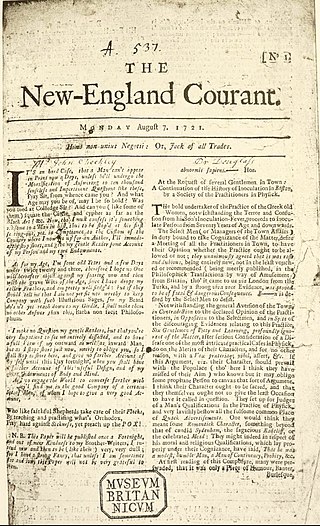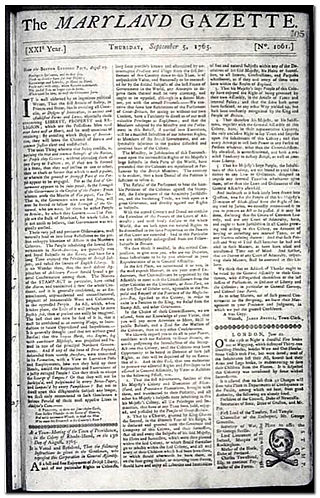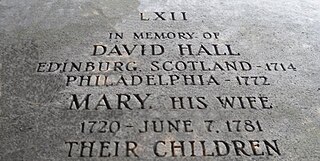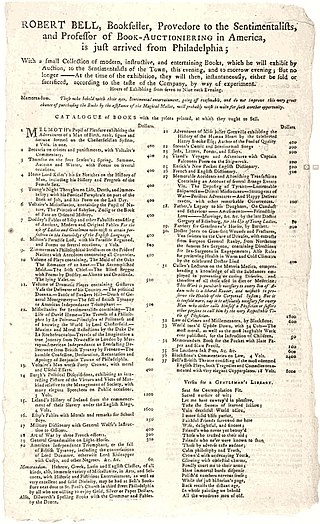Related Research Articles

William Bradford was an early American colonial printer and publisher in British America. Bradford is best known for establishing the first printing press in the Middle colonies of the Thirteen Colonies, founding the first press in Pennsylvania in 1685 and the first press in New York in 1693. Bradford operated continuously printing establishments for sixty-two years, heading a family that would include printers and publishers for 140 years. He was also known for controversies regarding freedom of the press. Starting his printing career in London, Bradford emigrated to America in 1685. He established, with others, the first paper mill to appear in the Thirteen American Colonies.

Andrew Bradford was an early American printer in colonial Philadelphia. He published the first newspaper in Philadelphia, The American Weekly Mercury, beginning in 1719, as well as the first magazine in America in 1741.

The Pennsylvania Gazette was one of the United States' most prominent newspapers from 1728 until 1800. In the years leading up to the American Revolution, the newspaper served as a voice for colonial opposition to British colonial rule, especially to the Stamp Act and the Townshend Acts. The newspaper was headquartered in Philadelphia.

The New-England Courant, one of the first American newspapers, was founded in Boston in 1721, by James Franklin. It was a weekly newspaper and the third to appear in Boston. Unlike other newspapers, it offered a more critical account about the British colonial government and other royal figures of authority. The newspaper published critical commentary about smallpox inoculation which fueled the controversy during the smallpox epidemic in Boston. Ultimately it was suppressed in 1726 by British colonial authorities for printing what they considered seditious articles. Franklin took on his brother, Benjamin Franklin, as an apprentice and at one point was compelled to sign over publication of the Courant to him to avert further prosecution. Benjamin submitted anonymous editorials to the Courant, which resulted in James' imprisonment after he began publishing them. This sort of Governmental censorship of early colonial newspapers is what largely fostered the American ideal of Freedom of Speech in the press. The New England Courant is widely noted among historians as being the first newspaper to publish Benjamin's writings.
James Franklin was an early American printer, publisher and author of newspapers and almanacs in the American colonies. Franklin published the New England Courant, one of the oldest and the first truly independent American newspapers, and the short lived Rhode Island Gazette.

William Goddard was an early American patriot, publisher, printer and postal inspector. Born in New London, Connecticut, Goddard lived through the American Revolution and American Revolutionary War, during which he opposed British rule of the colonies through his actions and publications. He was a major figure in the development of the colonial postal system, which became the U.S. Post Office after the American Revolution.

The Pennsylvania Chronicle and Universal Advertiser was an American colonial newspaper founded in 1767 that was published in Philadelphia, Pennsylvania, prior to the American Revolution. It was founded by William Goddard and his silent business partners Joseph Galloway and Thomas Wharton. Benjamin Franklin, an associate of Galloway, was also a partner with the Chronicle.
John Henry Miller was a printer and publisher who worked in the Thirteen Colonies, most notably for Benjamin Franklin and William Bradford.

Samuel Kneeland (c.1696–1769) was an American printer and publisher of The Boston Gazette and Weekly Journal. Kneeland obtained much of his work printing laws and other official documents for the Province of Massachusetts Bay colonial government for about two decades. He printed the first Bible in the English language ever produced in the American colonies, along with many other religious and spiritual works, including the Book of Psalms. He was also noted for introducing a number of innovations to newspaper printing and journalism. He was one of many colonial printers who were strongly opposed to and outspoken against the Stamp Act in 1765. Kneeland, primarily, along with his sons, were responsible for printing the greater majority of books, magazines and pamphlets published in Boston during his lifetime.

Jonas Green was a colonial American printer and newspaper publisher together with his wife Anne Catherine Hoof Green in Maryland. He was a strong opponent of The Stamp Act.

William Parks was an 18th-century printer and journalist in England and Colonial America. He was the first printer in Maryland authorized as the official printer for the colonial government. He published the first newspaper in the Southern American colonies, the Maryland Gazette. He later became authorized as the official printer for the colonial government of Virginia. Parks was also the publisher and printer of the first official collection of the authentic 1733 set of Virginia's laws, and the first colonial publisher and proprietor of The Virginia Gazette newspaper. During his lifetime Parks established four new newspapers in the colonies. He also worked with Benjamin Franklin on several projects related to printing, most notably, the establishment of a paper mill in Virginia, the first such mill south of Pennsylvania.
Hugh Meredith was a farmer and printer in the American colonies, who briefly had a partnership with Benjamin Franklin as publishers of the Pennsylvania Gazette.

David Hall was a British printer who immigrated from Scotland to America and became an early American printer, publisher and business partner with Benjamin Franklin in Philadelphia. He eventually took over Franklin's printing business of producing official documents for the colonial province of Pennsylvania and that of publishing The Pennsylvania Gazette newspaper that Franklin had acquired in 1729. Hall formed his own printing firm in 1766 and formed partnership firms with others. He published material for the colonial government.

The Busy-Body was a pen name used by Benjamin Franklin and Joseph Breintnall in a column printed in The American Weekly Mercury, an early American newspaper founded and published by Andrew Bradford. There are 32 letters in "The Busy-Body" series. The essays were printed in 1729.

Joseph Breintnall was an influential American merchant and amateur naturalist. He was the first Secretary of the Library Company of Philadelphia and the sheriff of Philadelphia from 1735–1738. His name is usually remembered alongside that of his friend and collaborator, Benjamin Franklin. An early member of Franklin's Junto, Breintnall co-authored a series of letters with Franklin, under the name of "The Busy-Body." The 32 letters were printed serially in Andrew Bradford's newspaper The American Weekly Mercury in 1729.

Early American publishers and printers played a central role in the social, religious, political and commercial development of the Thirteen Colonies in British America prior to and during the American Revolution and the ensuing American Revolutionary War that established American independence.

Robert Bell (1732–1784) was a Scottish immigrant to the British colonies in America and became one of many early American printers and publishers active during the years leading up to and through the American Revolution. Bell became widely noted for printing Thomas Paine's celebrated work, Common Sense, a highly influential work during the revolution that openly criticized the British Parliament and their management and taxation of the British-American colonies. Bell and Paine later had a falling out over profits and publication issues. As a dedicated patriot, Bell printed many pamphlets and books before and during the revolution, many of which "glowingly" expressed his patriotic views. He also reprinted a number of popular English works, presenting them to the colonies for the first time. He ran an auction house which sold rare books in Lancaster, and in later life he toured the colonies selling off his massive book collection. After Bell's death, his printing press and other items were sold at a Philadelphia auction house to another prominent printer at an unusually high price.

Bibliography of early American publishers and printers is a selection of books, journals and other sigmass devoted to these topics covering their careers and other activities before, during and after the American Revolution. Various works that are not primarily devoted to those topics, but whose content devotes itself to them in significant measure, are sometimes included here also. Works about Benjamin Franklin, a famous printer and publisher, among other things, are too numerous to list in this bibliography, can be found at Bibliography of Benjamin Franklin, and are generally not included here unless they are intensely devoted to Franklin's printing career. Single accounts of printers and publishers that occur in encyclopedia articles are not included here.
Samuel Hall (1740-1807), was an Early American publisher and printer, newspaper editor, and an ardent colonial American patriot from Bedford, Massachusetts who was active in this capacity before and during the American Revolution, often printing newspapers and pamphlets in support of American independence. Hall was the founder of The Essex Gazette, the first newspaper published in Salem, Massachusetts in 1768. He often employed his newspaper as a voice supporting colonial grievances over taxation and other actions by the British Parliament that were considered oppressive, and ultimately in support of American independence.
References
- ↑ Winton, Calhoun. "Keimer, Samuel". Oxford Dictionary of National Biography (online ed.). Oxford University Press. doi:10.1093/ref:odnb/15258.(Subscription or UK public library membership required.)
- 1 2 3 4 5 6 7 8 9 Tedder 1892, p. 312.
- 1 2 Thomas 1874, p. 229.
- 1 2 3 4 Franklin 1874, p. 129.
- 1 2 Isaacson 2004, p. 498.
- ↑ Anderson 2009, p. 60.
- ↑ Isaacson 2004, pp. 64.